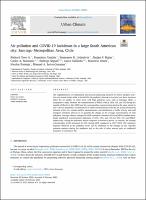| dc.contributor.author | Toro, Richard | |
| dc.contributor.author | Catalán, Francisco | |
| dc.contributor.author | Urdanivia Lermo, Francesco Renato | |
| dc.contributor.author | Rojas Quincho, Jhojan Pool | |
| dc.contributor.author | Manzano, Carlos A. | |
| dc.contributor.author | Seguel, Rodrigo | |
| dc.contributor.author | Gallardo, Laura | |
| dc.contributor.author | Osses, Mauricio | |
| dc.contributor.author | Pantoja, Nicolás | |
| dc.contributor.author | Leiva-Guzmán, Manuel A. | |
| dc.date.accessioned | 2021-02-22T16:22:41Z | |
| dc.date.available | 2021-02-22T16:22:41Z | |
| dc.date.issued | 2021-02 | |
| dc.identifier.uri | https://hdl.handle.net/20.500.12542/769 | |
| dc.description.abstract | The implementation of confinement and physical distancing measures to restrict people's activities and transit in the midst of the COVID-19 pandemic allowed us to study how these measures affect the air quality in urban areas with high pollution rates, such as Santiago, Chile. A comparative study between the concentrations of PM10, PM2.5, NOx, CO, and O3 during the months of March to May 2020 and the corresponding concentrations during the same period in 2017–2019 is presented. A combination of surface measurements from the air quality monitoring network of the city, remote satellite measurements, and simulations of traffic activity and road transport emissions allowed us to quantify the change in the average concentrations of each pollutant. Average relative changes of traffic emissions (between 61% and 68%) implied statistically significant concentrations reductions of 54%, 13%, and 11% for NOx, CO, and PM2.5, respectively, during the pandemic period compared to historical period. In contrast, the average concentration of O3 increased by 63% during 2020 compared to 2017–2019. The nonlinear response observed in the pollution levels can be attributed to the changes in the vehicular emission patterns during the pandemic and to the role of other sources such as residential emissions or secondary PM. | es_PE |
| dc.format | application/pdf | |
| dc.language.iso | eng | |
| dc.publisher | Elsevier B.V. | |
| dc.relation.ispartof | urn:issn:2212-0955 | |
| dc.relation.uri | https://www.sciencedirect.com/science/article/pii/S221209552100033X | |
| dc.rights | info:eu-repo/semantics/openAccess | |
| dc.rights | Atribución-NoComercial-SinDerivadas 3.0 Estados Unidos de América | * |
| dc.rights.uri | http://creativecommons.org/licenses/by-nc-nd/3.0/us/ | * |
| dc.source | Repositorio Institucional - SENAMHI | es_PE |
| dc.source | Servicio Nacional de Meteorología e Hidrología del Perú | es_PE |
| dc.subject | Calidad del Aire | es_PE |
| dc.subject | Contaminantes Atmosféricos | es_PE |
| dc.subject | Calidad Ambiental | es_PE |
| dc.subject | Vigilancia de Contaminantes | es_PE |
| dc.subject | Air Quality | |
| dc.subject | COVID-19 | es_PE |
| dc.subject | South America | |
| dc.title | Air pollution and COVID-19 lockdown in a large South American city: Santiago Metropolitan Area, Chile | |
| dc.type | info:eu-repo/semantics/article | |
| dc.identifier.isni | 0000 0001 0746 0446 | |
| dc.description.peerreview | Por pares | |
| dc.identifier.doi | https://doi.org/10.1016/j.uclim.2021.100803 | |
| dc.identifier.journal | Urban Climate | |
| dc.subject.ocde | https://purl.org/pe-repo/ocde/ford#1.05.08 | |
| dc.subject.ocde | https://purl.org/pe-repo/ocde/ford#1.05.09 | |
| dc.subject.sinia | contaminacion del aire - Aire y Atmósfera | |
| dc.type.sinia | text/publicacion cientifica | |
| dc.identifier.url | https://hdl.handle.net/20.500.12542/769 | |









